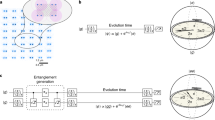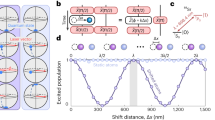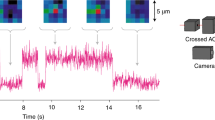Abstract
The preparation of large, low-entropy, highly coherent ensembles of identical quantum systems is fundamental for many studies in quantum metrology1, simulation2 and information3. However, the simultaneous realization of these properties remains a central challenge in quantum science across atomic and condensed-matter systems2,4,5,6,7. Here we leverage the favourable properties of tweezer-trapped alkaline-earth (strontium-88) atoms8,9,10, and introduce a hybrid approach to tailoring optical potentials that balances scalability, high-fidelity state preparation, site-resolved readout and preservation of atomic coherence. With this approach, we achieve trapping and optical-clock excited-state lifetimes exceeding 40 seconds in ensembles of approximately 150 atoms. This leads to half-minute-scale atomic coherence on an optical-clock transition, corresponding to quality factors well in excess of 1016. These coherence times and atom numbers reduce the effect of quantum projection noise to a level that is comparable with that of leading atomic systems, which use optical lattices to interrogate many thousands of atoms in parallel11,12. The result is a relative fractional frequency stability of 5.2(3) × 10−17τ−1/2 (where τ is the averaging time in seconds) for synchronous clock comparisons between sub-ensembles within the tweezer array. When further combined with the microscopic control and readout that are available in this system, these results pave the way towards long-lived engineered entanglement on an optical-clock transition13 in tailored atom arrays.
This is a preview of subscription content, access via your institution
Access options
Access Nature and 54 other Nature Portfolio journals
Get Nature+, our best-value online-access subscription
$29.99 / 30 days
cancel any time
Subscribe to this journal
Receive 51 print issues and online access
$199.00 per year
only $3.90 per issue
Buy this article
- Purchase on Springer Link
- Instant access to full article PDF
Prices may be subject to local taxes which are calculated during checkout




Similar content being viewed by others
Data availability
The experimental data presented in this manuscript are available from the corresponding author upon reasonable request. Source data are provided with this paper.
Code availability
The code used for analysis and simulation in this work is available from the corresponding author upon reasonable request.
References
Ludlow, A. D., Boyd, M. M., Ye, J., Peik, E. & Schmidt, P. O. Optical atomic clocks. Rev. Mod. Phys. 87, 637–701 (2015).
Georgescu, I. M., Ashhab, S. & Nori, F. Quantum simulation. Rev. Mod. Phys. 86, 153–185 (2014).
Preskill, J. Quantum computing and the entanglement frontier. Preprint at https://arxiv.org/abs/1203.5813 (2012).
Saffman, M., Walker, T. G. & Molmer, K. Quantum information with Rydberg atoms. Rev. Mod. Phys. 82, 2313–2363 (2010).
Madjarov, I. S. et al. An atomic-array optical clock with single-atom readout. Phys. Rev. X 9, 041052 (2019).
Norcia, M. A. et al. Seconds-scale coherence on an optical clock transition in a tweezer array. Science 366, 93–97 (2019).
Hutson, R. B., Goban, A., Marti, G. E. & Ye, J. Engineering quantum states of matter for atomic clocks in shallow optical lattices. Phys. Rev. Lett. 123, 123401 (2019).
Cooper, A. et al. Alkaline-earth atoms in optical tweezers. Phys. Rev. X 8, 041055 (2018).
Norcia, M. A., Young, A. W. & Kaufman, A. M. Microscopic control and detection of ultracold strontium in optical-tweezer arrays. Phys. Rev. X 8, 041054 (2018).
Saskin, S., Wilson, J. T., Grinkemeyer, B. & Thompson, J. D. Narrow-line cooling and imaging of ytterbium atoms in an optical tweezer array. Phys. Rev. Lett. 122, 143002 (2019).
Campbell, S. L. et al. A Fermi-degenerate three-dimensional optical lattice clock. Science 358, 90–94 (2017).
Oelker, E. et al. Demonstration of 4.8 × 10−17 stability at 1 s for two independent optical clocks. Nat. Photon. 13, 714–719 (2019).
Gil, L. I. R., Mukherjee, R., Bridge, E. M., Jones, M. P. A. & Pohl, T. Spin squeezing in a Rydberg lattice clock. Phys. Rev. Lett. 112, 103601 (2014).
Browaeys, A. & Lahaye, T. Many-body physics with individually controlled Rydberg atoms. Nat. Phys. 16, 132–142 (2020).
Barredo, D., de Léséleuc, S., Lienhard, V., Lahaye, T. & Browaeys, A. An atom-by-atom assembler of defect-free arbitrary two-dimensional atomic arrays. Science 354, 1021–1023 (2016).
Endres, M. et al. Atom-by-atom assembly of defect-free one-dimensional cold atom arrays. Science 354, 1024–1027 (2016).
Kumar, A., Wu, T.-Y., Giraldo, F. & Weiss, D. S. Sorting ultracold atoms in a three-dimensional optical lattice in a realization of Maxwell’s demon. Nature 561, 83–87 (2018).
Brown, M. O., Thiele, T., Kiehl, C., Hsu, T.-W. & Regal, C. A. Gray-molasses optical-tweezer loading: controlling collisions for scaling atom-array assembly. Phys. Rev. X 9, 011057 (2019).
Levine, H. et al. Parallel implementation of high-fidelity multiqubit gates with neutral atoms. Phys. Rev. Lett. 123, 170503 (2019).
Graham, T. M. et al. Rydberg-mediated entanglement in a two-dimensional neutral atom qubit array. Phys. Rev. Lett. 123, 230501 (2019).
Omran, A. et al. Generation and manipulation of Schrödinger cat states in Rydberg atom arrays. Science 365, 570–574 (2019).
Bernien, H. et al. Probing many-body dynamics on a 51-atom quantum simulator. Nature 551, 579–584 (2017).
de Léséleuc, S. et al. Observation of a symmetry-protected topological phase of interacting bosons with Rydberg atoms. Science 365, 775–780 (2019).
Madjarov, I. S. et al. High-fidelity entanglement and detection of alkaline-earth Rydberg atoms Nat. Phys. 16, 857–861 (2020).
Wilson, J. et al. Trapped arrays of alkaline earth Rydberg atoms in optical tweezers. Preprint at https://arxiv.org/abs/1912.08754 (2019).
Chou, C. W., Hume, D. B., Koelemeij, J. C. J., Wineland, D. J. & Rosenband, T. Frequency comparison of two high-accuracy Al+ optical clocks. Phys. Rev. Lett. 104, 070802 (2010).
Brewer, S. M. et al. 27Al+ quantum-logic clock with a systematic uncertainty below 10−18. Phys. Rev. Lett. 123, 033201 (2019).
Ushijima, I., Takamoto, M., Das, M., Ohkubo, T. & Katori, H. Cryogenic optical lattice clocks. Nat. Photon. 9, 185–189 (2015).
Liu, L. R. et al. Molecular assembly of ground-state cooled single atoms. Phys. Rev. X 9, 021039 (2019).
Dörscher, S. et al. Lattice-induced photon scattering in an optical lattice clock. Phys. Rev. A 97, 063419 (2018).
Takamoto, M., Takano, T. & Katori, H. Frequency comparison of optical lattice clocks beyond the Dick limit. Nat. Photon. 5, 288–292 (2011).
Marti, G. E. et al. Imaging optical frequencies with 100 μHz precision and 1.1 μm resolution. Phys. Rev. Lett. 120, 103201 (2018).
Foster, G. T., Fixler, J. B., McGuirk, J. M. & Kasevich, M. A. Method of phase extraction between coupled atom interferometers using ellipse-specific fitting. Opt. Lett. 27, 951 (2002).
Shi, C. et al. Polarizabilities of the 87Sr clock transition. Phys. Rev. A 92, 012516 (2015).
Chwalla, M. et al. Precision spectroscopy with two correlated atoms. Appl. Phys. B 89, 483–488 (2007).
Chou, C. W., Hume, D. B., Thorpe, M. J., Wineland, D. J. & Rosenband, T. Quantum coherence between two atoms beyond Q = 1015. Phys. Rev. Lett. 106, 160801 (2011).
Hume, D. B. & Leibrandt, D. R. Probing beyond the laser coherence time in optical clock comparisons. Phys. Rev. A 93, 032138 (2016).
Tan, T. R. et al. Suppressing inhomogeneous broadening in a lutetium multi-ion optical clock. Phys. Rev. Lett. 123, 063201 (2019).
Kaufman, A. M. et al. Two-particle quantum interference in tunnel-coupled optical tweezers. Science 345, 306–309 (2014).
Murmann, S. et al. Two fermions in a double well: exploring a fundamental building block of the Hubbard model. Phys. Rev. Lett. 114, 080402 (2015).
Pedrozo-Peñfiel, E. et al. Entanglement-enhanced optical atomic clock. Preprint at https://arxiv.org/abs/2006.07501 (2020).
Covey, J. P., Madjarov, I. S., Cooper, A. & Endres, M. 2000-times repeated imaging of strontium atoms in clock-magic tweezer arrays. Phys. Rev. Lett. 122, 173201 (2019).
Kaubruegger, R. et al. Variational spin-squeezing algorithms on programmable quantum sensors. Phys. Rev. Lett. 123, 260505 (2019).
Kessler, E. M. et al. Heisenberg-limited atom clocks based on entangled qubits. Phys. Rev. Lett. 112, 190403 (2014).
Zhang, G. & Song, Z. Topological characterization of extended quantum Ising models. Phys. Rev. Lett. 115, 177204 (2015).
Savary, L. & Balents, L. Quantum spin liquids: a review. Rep. Prog. Phys. 80, 016502 (2017).
Titum, P., Iosue, J. T., Garrison, J. R., Gorshkov, A. V. & Gong, Z.-X. Probing ground-state phase transitions through quench dynamics. Phys. Rev. Lett. 123, 115701 (2019).
Briegel, H. J., Browne, D. E., Dür, W., Raussendorf, R. & Van den Nest, M. Measurement-based quantum computation. Nat. Phys. 5, 19–26 (2009).
Monroe, C. et al. Resolved-sideband raman cooling of a bound atom to the 3D zero-point energy. Phys. Rev. Lett. 75, 4011–4014 (1995).
Kaufman, A. M., Lester, B. J. & Regal, C. A. Cooling a single atom in an optical tweezer to its quantum ground state. Phys. Rev. X 2, 041014 (2012).
Thompson, J. D., Tiecke, T. G., Zibrov, A. S., Vuletić, V. & Lukin, M. D. Coherence and Raman sideband cooling of a single atom in an optical tweezer. Phys. Rev. Lett. 110, 133001 (2013).
Taichenachev, A. V. et al. Magnetic field-induced spectroscopy of forbidden optical transitions with application to lattice-based optical atomic clocks. Phys. Rev. Lett. 96, 083001 (2006).
Bali, S., O’Hara, K. M., Gehm, M. E., Granade, S. R. & Thomas, J. E. Quantum-diffractive background gas collisions in atom-trap heating and loss. Phys. Rev. A 60, R29–R32 (1999).
Van Dongen, J. et al. Trap-depth determination from residual gas collisions. Phys. Rev. A 84, 022708 (2011).
Mitroy, J. & Zhang, J. Y. Dispersion and polarization interactions of the strontium atom. Mol. Phys. 108, 1999–2006 (2010).
Gibble, K. Scattering of cold-atom coherences by hot atoms: frequency shifts from background-gas collisions. Phys. Rev. Lett. 110, 180802 (2013).
Bothwell, T. et al. JILA SrI optical lattice clock with uncertainty of 2.0 × 10−18. Metrologia 56, 065004 (2019).
Savard, T. A., O’Hara, K. M. & Thomas, J. E. Laser-noise-induced heating in far-off resonance optical traps. Phys. Rev. A 56, R1095–R1098 (1997).
Gehm, M. E., O’Hara, K. M., Savard, T. A. & Thomas, J. E. Dynamics of noise-induced heating in atom traps. Phys. Rev. A 58, 3914–3921 (1998).
Bloom, B. J. et al. An optical lattice clock with accuracy and stability at the 10−18 level. Nature 506, 71–75 (2014).
Ovsiannikov, V. D., Pal’chikov, V. G., Taichenachev, A. V., Yudin, V. I. & Katori, H. Multipole, nonlinear, and anharmonic uncertainties of clocks of Sr atoms in an optical lattice. Phys. Rev. A 88, 013405 (2013).
Safronova, M. S., Zuhrianda, Z., Safronova, U. I. & Clark, C. W. Extracting transition rates from zero-polarizability spectroscopy. Phys. Rev. A 92, 040501 (2015).
Acknowledgements
We acknowledge discussions with R. B. Hutson, J. K. Thompson, M. Foss-Feig, S. Kolkowitz and J. Simon. We further acknowledge F. Vietmeyer and M. O. Brown for assistance in the design and development of our FPGA-based tweezer control system. This work was supported by ARO, AFOSR, DARPA, the National Science Foundation Physics Frontier Center at JILA (1734006) and NIST. M.A.N., E.O. and N.S. acknowledge support from the NRC research associateship programme.
Author information
Authors and Affiliations
Contributions
A.W.Y., W.J.E., M.A.N., N.S. and A.M.K. built and operated the tweezer apparatus, and the silicon-crystal-stabilized clock laser was operated by W.R.M., D.K., E.O. and J.Y. All authors contributed to the data analysis and the development of the manuscript.
Corresponding author
Ethics declarations
Competing interests
The authors declare no competing interests.
Additional information
Peer review information Nature thanks Ahmed Omran and the other, anonymous, reviewer(s) for their contribution to the peer review of this work. Peer reviewer reports are available.
Publisher’s note Springer Nature remains neutral with regard to jurisdictional claims in published maps and institutional affiliations.
Extended data figures and tables
Extended Data Fig. 1 Sideband cooling and inhomogeneous broadening.
The trap frequency and cooling performance in the radial direction is uniform across the entire array, as further confirmed by spectra taken along a radial axis orthogonal to that of the data presented in Fig. 1d (left). However, in a reduced 6 × 6 region at the centre of the array (shown in the far-right inset), the axial cooling performance is vastly improved (right), with an average phonon occupation of \(\bar{n}={0.00}_{-0.00}^{+0.06}\) (\(\bar{n}={0.06}_{-0.06}^{+0.10}\)) before (after) the handoff. This is due to the comparable extent of the lattice beams to the tweezer array (the light-green contour in the far-right inset shows the region over which the lattice intensity stays within 90% of its maximal value). Each data point corresponds to 20 repetitions of the experiment.
Extended Data Fig. 2 Lattice alignment.
a, b, Spatial phase of the standing-wave lattice at each tweezer, inferred from measurements at 15 values of the lattice phase averaged over 100 trials (see Supplementary Information) with an intentional tilt (a, left) and properly aligned (a, right). These show that it is possible flatten the lattice relative to the entire tweezer array to within 1/10 of a lattice period (b). This allows for high-fidelity sideband cooling in all axes. ‘Cts’, counts; ‘arb.’, arbitrary units.
Extended Data Fig. 3 Timing of experimental sequence.
a, The green and black curves track the depths of the 515-nm and 813-nm tweezers, respectively. The coloured regions above and below the graph categorize each step of the experiment (described in more detail in Methods). We find that maintaining the 813-nm tweezers at a depth greater than 20Er during the ramp down improves the fidelity of the handoff procedure. Not shown is the time required to load atoms into the 515-nm tweezers from the magneto-optical traps used for initial trapping and cooling, which takes roughly 120 ms. LAC, light-assisted collisions. b, Zoomed-in view of our cooling procedure, showing the depth of the axial lattice. We perform two rounds of sideband cooling, indicated by the two regions shaded in grey. The first, done before ramping up the axial lattice, does not cool axial motion to the ground state. Instead, it is important for reducing the size of the atomic wave packet to ensure loading of a single lattice fringe.
Extended Data Fig. 4 Measuring atom–laser coherence.
Fitting measured Ramsey fringes with fringes of a fixed frequency provides a conservative estimate of atom–laser coherence. Callouts share x-axis units with the main plot, and show the fitted Ramsey data (the same data as used in Fig. 2b). ‘pop.’, population.
Supplementary information
Supplementary Information
This file contains Supplementary Text and Supplementary Figures S1–S5.
Rights and permissions
About this article
Cite this article
Young, A.W., Eckner, W.J., Milner, W.R. et al. Half-minute-scale atomic coherence and high relative stability in a tweezer clock. Nature 588, 408–413 (2020). https://doi.org/10.1038/s41586-020-3009-y
Received:
Accepted:
Published:
Issue Date:
DOI: https://doi.org/10.1038/s41586-020-3009-y
This article is cited by
-
An optical tweezer array of ultracold polyatomic molecules
Nature (2024)
-
Parallel quantum control meets optical atomic clocks
Nature Physics (2024)
-
Multi-ensemble metrology by programming local rotations with atom movements
Nature Physics (2024)
-
Scalable spin squeezing in a dipolar Rydberg atom array
Nature (2023)
-
Floquet-tailored Rydberg interactions
Nature Communications (2023)
Comments
By submitting a comment you agree to abide by our Terms and Community Guidelines. If you find something abusive or that does not comply with our terms or guidelines please flag it as inappropriate.



